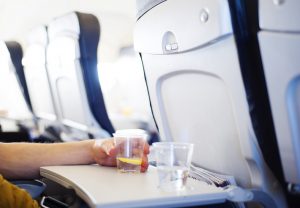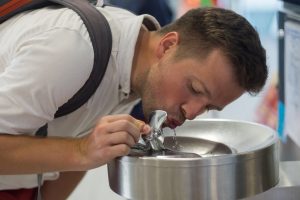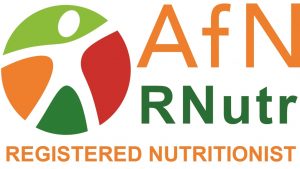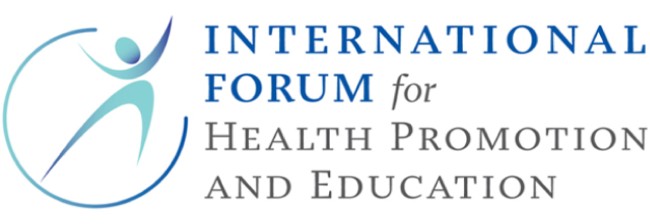Hydration is always a challenge when travelling on business, especially when there is a heatwave. The northern hemisphere summer has been super-hot, but work must go on. Travelling for business can be tough when we start to swelter. Fatigue, headaches and dizziness are the first signs that we are drying up.
The time is right for a re-cap on staying hydrated.
Getting Thirsty
 Thirsty is the message from our brain signalling that our body is short of fluid. It’s hard to avoid getting thirsty on a hot day, but good to recognise that if we feel thirsty we are already fluid deficient.
Thirsty is the message from our brain signalling that our body is short of fluid. It’s hard to avoid getting thirsty on a hot day, but good to recognise that if we feel thirsty we are already fluid deficient.
To Glug or to Sip?
Sipping water is the best way to stay hydrated. It’s cheap and free from sugars and acids that can damage our teeth.
On an average cool day, we need about 1.5 litre fluid, but when it’s hot and especially if we’re active, this can rise to 4 litre per day. It helps to have a variety to keep up a large fluid intake.
Tea, coffee, infusions, juices, cordials and sodas will all aid hydration, but if we take lots of little sips of a sweet or acidic drink, the environment in our mouth will be corrosive for an extended period of time. Sodas and sweet drinks need to be drunk in one hit.
Is Water Always Enough?
If we have become dehydrated then water alone is very slow to absorb. Research on athletes revealed that a dilute sugar solution of around 6g/100ml gives the fastest active uptake of fluid. Sports drinks, which also contain the minerals excreted in sweat, are designed specifically for this purpose. On a very hot day, if travel for work has made us hot and thirsty, this is a great option.
I n the past, a 5-6% sugar solution was only to be found in sports drinks or home diluted cordials. Fizzy drinks tended to have around 10 – 13% sugar content which also gives a slower hydration rate, and a huge sugar hit. Since the introduction of the UK Sugary Drinks Levy, many sodas (but not the original Coke and Pepsi products) have now been reformulated and contain around 6% sugar solution with added artificial sweetener to maintain the very sweet taste. Generally, I wouldn’t recommend these drinks, but cold fizzy lemonade is very easy to access when we are on the move and if it prevents a dehydration headache, it’s worth compromising on our healthy food regime. Check the labelling to be certain.
n the past, a 5-6% sugar solution was only to be found in sports drinks or home diluted cordials. Fizzy drinks tended to have around 10 – 13% sugar content which also gives a slower hydration rate, and a huge sugar hit. Since the introduction of the UK Sugary Drinks Levy, many sodas (but not the original Coke and Pepsi products) have now been reformulated and contain around 6% sugar solution with added artificial sweetener to maintain the very sweet taste. Generally, I wouldn’t recommend these drinks, but cold fizzy lemonade is very easy to access when we are on the move and if it prevents a dehydration headache, it’s worth compromising on our healthy food regime. Check the labelling to be certain.
What to Avoid?
Salty food needs extra fluid to help our kidneys excrete it. Salty snacks are a hazard.
Alcoholic drinks – while obviously the more dilute the better, it is actually the total amount of alcohol consumed which matters. Alcohol reduces our production of the hormone which allows our body to hold onto fluid and remain hydrated. With less anti-diuretic hormone, we make more urine, however much fluid we consume, the more alcohol we drink, the more we are at risk of becoming dehydrated.
Caffeinated drinks are fine, it’s virtually impossible to get enough caffeine to cause dehydration and they are often a welcome source of fluid.
 Whatever our mode of travel for business, it always pays to plan ahead and carry and re-fill our own water bottle. Some modern airports, railway stations and roadside services now provide water fountains as part of their amenities. You’ll usually find them next to the toilets. Other airports offer free or subsidised bottles of water, such as Ireland. Some cafes, such as Gatwick Nando’s and Yo! Sushi offers free refills or unlimited water so to reduce plastic bottle waste.
Whatever our mode of travel for business, it always pays to plan ahead and carry and re-fill our own water bottle. Some modern airports, railway stations and roadside services now provide water fountains as part of their amenities. You’ll usually find them next to the toilets. Other airports offer free or subsidised bottles of water, such as Ireland. Some cafes, such as Gatwick Nando’s and Yo! Sushi offers free refills or unlimited water so to reduce plastic bottle waste.
© 2018 Executive Travel Vitality
Keeping Hydrated en route is no longer as problematic as it once was.
Collapsible cups and bottles have become a popular trend for saving the environment. Equally these collapsible items are great for travelling.
Choose from the selection below for hot beverage cups and cold drink bottles.
by - [-]
Price: -
by - [-]
Price: -
by - [-]
Price: -
by - [-]
Price: -


























![Meyon Large Collapsible Coffee Cup [520ml] | Eco Friendly, Reusable, BPA-Free Silicone Travel Mug for Hot & Cold Drinks | Foldable & Expandable Drinking Cup with Leakproof Lid](https://m.media-amazon.com/images/I/7125dubVgPL._AC_UL436_.jpg)






